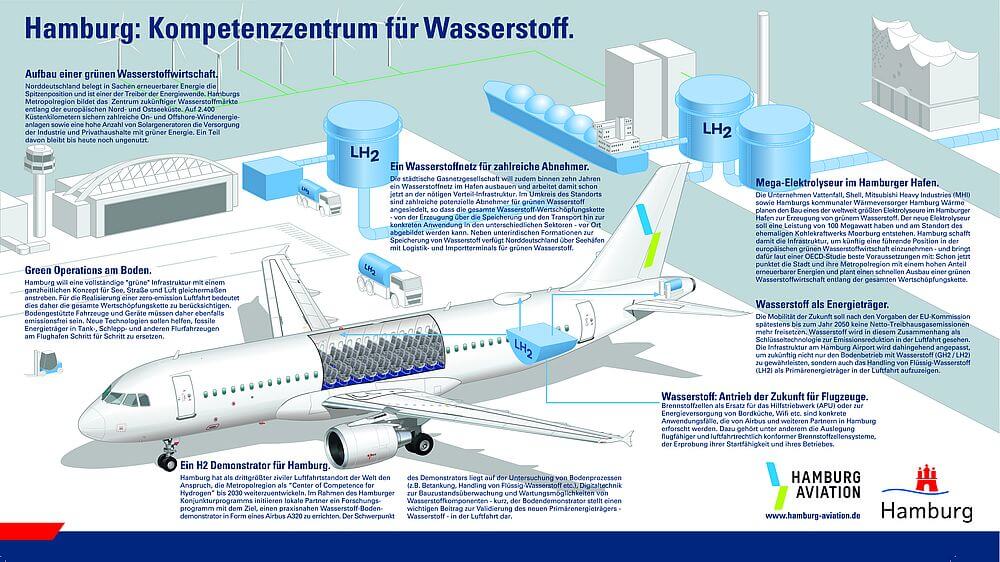Press Release
Early testing of maintenance and ground processes for future aircraft generations
The aerospace industry in Hamburg is preparing for flying with hydrogen. Therefore, the starting signal has now sounded for the set-up of a new development platform. Over the next two years and with funds provided by the city of Hamburg, Lufthansa Technik together with the German Aerospace Center (DLR), the Center for Applied Aeronautical Research (ZAL) and Hamburg Airport will design and test extensive maintenance and ground processes in handling hydrogen technology. For this purpose, an aircraft of the Airbus A320 family will be converted into a stationary laboratory at Lufthansa Technik’s base in Hamburg.
Liquid hydrogen (LH2) is increasingly being more concretely envisaged in the development departments of large aircraft manufacturers as a sustainably producible fuel for future generations of commercial aircraft. In order to investigate the effects of the use of LH2 on maintenance and ground processes at an early stage, Lufthansa Technik, DLR, ZAL and Hamburg Airport are now pooling their extensive practical and scientific expertise. The aim is to jointly develop a pioneering demonstrator, and to operate it from 2022.
As the world’s third-largest aviation location, the Free and Hanseatic City of Hamburg is funding the research project with the largest single item in its special program to mitigate the economic impact of the coronavirus pandemic on the aviation industry.
“Hamburg is not just one of the three largest aviation clusters in the world, last year the city also developed the clear vision of becoming a major hydrogen metropolis,” explained Michael Westhagemann, Senator for Economics and Innovation of the Free and Hanseatic City of Hamburg. “I therefore see it as both a logical and gratifying step to combine these two core competencies of Hamburg. The port, the energy sector, industry and the entire mobility sector are involved and are preparing for this groundbreaking technology. With this project, we are now also making an essential contribution to the transformation of aviation into a climate-neutral mobility solution of the future. The clear goal is to build up a hydrogen economy in Hamburg that will occupy a leading position internationally.”
In the first phase of the project, by the end of 2021 the partners aim to identify the most urgent fields of development for closer scientific examination and, on this basis, to elaborate the concept for subsequent practical testing. The practical implementation of the concept will start at the beginning of 2022 and will involve the modification of a decommissioned Airbus A320 aircraft. It will be equipped with an LH2 infrastructure to be used as a fully functional field laboratory at Lufthansa Technik’s base in Hamburg. In parallel, a virtual environment is being created at DLR that will be used to achieve digital and highly accurate mapping of the defined development fields. The new development platform is to provide inspiration for the design process of the next generation of aircraft by means of parameterized and highly accurate virtual models.
Against this background, Lufthansa Technik will primarily contribute its great operational expertise in the maintenance and modification of commercial aircraft, and can also incorporate the customer perspective through its close contact with airlines around the world. DLR will add its long-standing and cross-sector experience with hydrogen, and focus on the development of the virtual environment. ZAL will also participate with its extensive know-how in the field of fuel cell technology and its digital process mapping. As an associated project partner, Hamburg Airport will primarily contribute its experience from the operator’s perspective, for example in defining requirements for the ground handling process of future LH2-powered aircraft.
“There is no alternative to the transformation of our industry towards climate-neutral flying. With this project, we want to tackle this enormous technological challenge at an early stage – for the entire MRO industry as well as for us. In this way, we are actively securing the future, because we are building up know-how today for the maintenance and ground processes of the day after tomorrow,” explained Dr. Johannes Bussmann, Chief Executive Officer of Lufthansa Technik AG. “I am therefore pleased that we have succeeded in joining forces with strong partners in this project. And I am very grateful for the foresight of the city of Hamburg and its generous funding for this project.”
“The aircraft of the future are lighter, more efficient and fly with alternative propulsion concepts. Hydrogen will play an important role in this. We need to learn – promptly and in detail – the requirements on aircraft and maintenance of real-world operation with hydrogen on the ground,” said Dr. Markus Fischer, DLR Deputy Board Member Aeronautics. “In the project, we are using this data and experience to develop digital models for ground processes. These digital process twins can then be used directly in the design of future-oriented and yet practicable aircraft configurations.”
“The development of a field laboratory and a digital twin are important components of Hamburg’s Green Aviation Technology Roadmap. They were developed together with the members of the Hamburg Aviation Cluster last year to strengthen Hamburg’s competence in research and development in a European context,” said Roland Gerhards, Chief Executive Officer of ZAL GmbH. “We thank the city of Hamburg for its support in now jointly implementing this location strategy for the development of future LH2-powered aircraft.”
Michael Eggenschwiler, CEO of Hamburg Airport, said, “Climate-friendly flying with hydrogen technology is only possible if the infrastructure on the ground also fits perfectly. Close coordination is required here, and we as an airport are pleased to be able to contribute our know-how to this important project – from questions of storage and distribution to the refueling process on the apron. At the airport, we also rely on hydrogen as the technology of the future for our ground transport. This project offers us the chance to identify and make the best possible use of synergy effects between gaseous hydrogen, such as that used for refueling our baggage tractors, and liquid hydrogen for aircraft refueling.”
Caption to the attached graphic (image source: Hamburg Marketing):
This graphic depicts examples of potential fields of application for liquid hydrogen in and on future aircraft (blue arrows) as well as at the airport (ground vehicles) and its periphery (refueling systems). The blue arrows outline potential fields of application in the aircraft: for example, satellite communications as well as galleys, cabin or IFE systems could be powered by electricity from a fuel cell in the future. The project partners will determine in the coming months which fields of application will actually be investigated in more detail in the practical evaluation.





